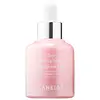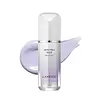What's inside
What's inside
 Key Ingredients
Key Ingredients

 Benefits
Benefits

 Concerns
Concerns

 Ingredients Side-by-side
Ingredients Side-by-side

Water
Skin ConditioningGlycerin
HumectantPEG/PPG-17/6 Copolymer
SolventDiglycerin
HumectantMethyl Gluceth-20
HumectantPropanediol
SolventDimethicone
Emollient1,2-Hexanediol
Skin ConditioningBetaine
HumectantUndecane
EmollientAcrylates/C10-30 Alkyl Acrylate Crosspolymer
Emulsion StabilisingTromethamine
BufferingCaprylyl Methicone
Skin ConditioningTridecane
PerfumingSaccharide Hydrolysate
HumectantFructooligosaccharides
HumectantSilica Dimethyl Silylate
EmollientMica
Cosmetic ColorantXanthan Gum
EmulsifyingC30-45 Alkyl Cetearyl Dimethicone Crosspolymer
EmollientPullulan
CI 77891
Cosmetic ColorantEclipta Prostrata Extract
Skin ConditioningOlea Europaea Fruit Oil
MaskingLauryl Dimethicone
Skin ConditioningSynthetic Fluorphlogopite
Melia Azadirachta Leaf Extract
Skin ConditioningCI 75470
Cosmetic ColorantDiamond Powder
AbrasiveCaesalpinia Spinosa Fruit Extract
Skin ProtectingMelia Azadirachta Flower Extract
Skin ConditioningMoringa Oleifera Seed Oil
EmollientButylene Glycol
HumectantCoccinia Indica Fruit Extract
Skin ConditioningKappaphycus Alvarezii Extract
Skin ConditioningTocopherol
AntioxidantTin Oxide
AbrasiveAloe Barbadensis Flower Extract
EmollientSolanum Melongena Fruit Extract
Skin ConditioningCaprylic/Capric Triglyceride
MaskingSimmondsia Chinensis Seed Oil
EmollientPhosphatidylcholine
EmulsifyingCorallina Officinalis Extract
Skin ConditioningOcimum Sanctum Leaf Extract
Skin ConditioningCurcuma Longa Root Extract
MaskingCeramide NP
Skin ConditioningGlycine
BufferingSerine
MaskingGlutamic Acid
HumectantLysine
Skin ConditioningAlanine
MaskingProline
Skin ConditioningThreonine
Water, Glycerin, PEG/PPG-17/6 Copolymer, Diglycerin, Methyl Gluceth-20, Propanediol, Dimethicone, 1,2-Hexanediol, Betaine, Undecane, Acrylates/C10-30 Alkyl Acrylate Crosspolymer, Tromethamine, Caprylyl Methicone, Tridecane, Saccharide Hydrolysate, Fructooligosaccharides, Silica Dimethyl Silylate, Mica, Xanthan Gum, C30-45 Alkyl Cetearyl Dimethicone Crosspolymer, Pullulan, CI 77891, Eclipta Prostrata Extract, Olea Europaea Fruit Oil, Lauryl Dimethicone, Synthetic Fluorphlogopite, Melia Azadirachta Leaf Extract, CI 75470, Diamond Powder, Caesalpinia Spinosa Fruit Extract, Melia Azadirachta Flower Extract, Moringa Oleifera Seed Oil, Butylene Glycol, Coccinia Indica Fruit Extract, Kappaphycus Alvarezii Extract, Tocopherol, Tin Oxide, Aloe Barbadensis Flower Extract, Solanum Melongena Fruit Extract, Caprylic/Capric Triglyceride, Simmondsia Chinensis Seed Oil, Phosphatidylcholine, Corallina Officinalis Extract, Ocimum Sanctum Leaf Extract, Curcuma Longa Root Extract, Ceramide NP, Glycine, Serine, Glutamic Acid, Lysine, Alanine, Proline, Threonine
Water
Skin ConditioningCyclopentasiloxane
EmollientDimethicone
EmollientEthylhexyl Methoxycinnamate
UV AbsorberCyclohexasiloxane
EmollientButylene Glycol
HumectantGlycerin
HumectantC12-15 Alkyl Benzoate
AntimicrobialCI 77891
Cosmetic ColorantDimethicone/Vinyl Dimethicone Crosspolymer
Skin ConditioningLauryl PEG-9 Polydimethylsiloxyethyl Dimethicone
Skin ConditioningDisteardimonium Hectorite
StabilisingPEG/PPG-19/19 Dimethicone
EmulsifyingPolymethyl Methacrylate
CI 77007
Cosmetic ColorantSodium Chloride
MaskingHydrogenated Polydecene
EmollientBoron Nitride
AbsorbentParfum
MaskingCaprylyl Glycol
EmollientGlyceryl Caprylate
EmollientEthylhexylglycerin
Skin ConditioningC12-15 Alcohols
EmollientAluminum Hydroxide
EmollientTriethoxycaprylylsilane
Disodium EDTA
Mica
Cosmetic ColorantMethyl Methacrylate Crosspolymer
Vinyl Dimethicone/Methicone Silsesquioxane Crosspolymer
Isododecane
EmollientBHT
AntioxidantAcrylates/Polytrimethylsiloxymethacrylate Copolymer
Skin ConditioningTocopherol
AntioxidantTin Oxide
AbrasivePropanediol
Solvent1,2-Hexanediol
Skin ConditioningSodium Magnesium Silicate
Glutathione
Malpighia Emarginata Fruit Extract
Skin ConditioningEuterpe Oleracea Fruit Extract
Water, Cyclopentasiloxane, Dimethicone, Ethylhexyl Methoxycinnamate, Cyclohexasiloxane, Butylene Glycol, Glycerin, C12-15 Alkyl Benzoate, CI 77891, Dimethicone/Vinyl Dimethicone Crosspolymer, Lauryl PEG-9 Polydimethylsiloxyethyl Dimethicone, Disteardimonium Hectorite, PEG/PPG-19/19 Dimethicone, Polymethyl Methacrylate, CI 77007, Sodium Chloride, Hydrogenated Polydecene, Boron Nitride, Parfum, Caprylyl Glycol, Glyceryl Caprylate, Ethylhexylglycerin, C12-15 Alcohols, Aluminum Hydroxide, Triethoxycaprylylsilane, Disodium EDTA, Mica, Methyl Methacrylate Crosspolymer, Vinyl Dimethicone/Methicone Silsesquioxane Crosspolymer, Isododecane, BHT, Acrylates/Polytrimethylsiloxymethacrylate Copolymer, Tocopherol, Tin Oxide, Propanediol, 1,2-Hexanediol, Sodium Magnesium Silicate, Glutathione, Malpighia Emarginata Fruit Extract, Euterpe Oleracea Fruit Extract
 Reviews
Reviews

Ingredients Explained
These ingredients are found in both products.
Ingredients higher up in an ingredient list are typically present in a larger amount.
1,2-Hexanediol is a synthetic liquid and another multi-functional powerhouse.
It is a:
- Humectant, drawing moisture into the skin
- Emollient, helping to soften skin
- Solvent, dispersing and stabilizing formulas
- Preservative booster, enhancing the antimicrobial activity of other preservatives
Butylene Glycol (or BG) is used within cosmetic products for a few different reasons:
Overall, Butylene Glycol is a safe and well-rounded ingredient that works well with other ingredients.
Though this ingredient works well with most skin types, some people with sensitive skin may experience a reaction such as allergic rashes, closed comedones, or itchiness.
Learn more about Butylene GlycolCi 77891 is a white pigment from Titanium dioxide. It is naturally found in minerals such as rutile and ilmenite.
It's main function is to add a white color to cosmetics. It can also be mixed with other colors to create different shades.
Ci 77891 is commonly found in sunscreens due to its ability to block UV rays.
Learn more about CI 77891Dimethicone is a type of synthetic silicone created from natural materials such as quartz.
What it does:
Dimethicone comes in different viscosities:
Depending on the viscosity, dimethicone has different properties.
Ingredients lists don't always show which type is used, so we recommend reaching out to the brand if you have questions about the viscosity.
This ingredient is unlikely to cause irritation because it does not get absorbed into skin. However, people with silicone allergies should be careful about using this ingredient.
Note: Dimethicone may contribute to pilling. This is because it is not oil or water soluble, so pilling may occur when layered with products. When mixed with heavy oils in a formula, the outcome is also quite greasy.
Learn more about DimethiconeGlycerin is already naturally found in your skin. It helps moisturize and protect your skin.
A study from 2016 found glycerin to be more effective as a humectant than AHAs and hyaluronic acid.
As a humectant, it helps the skin stay hydrated by pulling moisture to your skin. The low molecular weight of glycerin allows it to pull moisture into the deeper layers of your skin.
Hydrated skin improves your skin barrier; Your skin barrier helps protect against irritants and bacteria.
Glycerin has also been found to have antimicrobial and antiviral properties. Due to these properties, glycerin is often used in wound and burn treatments.
In cosmetics, glycerin is usually derived from plants such as soybean or palm. However, it can also be sourced from animals, such as tallow or animal fat.
This ingredient is organic, colorless, odorless, and non-toxic.
Glycerin is the name for this ingredient in American English. British English uses Glycerol/Glycerine.
Learn more about GlycerinMica is a naturally occurring mineral used to add shimmer and color in cosmetics. It can also help improve the texture of a product or give it an opaque, white/silver color.
Serecite is the name for very fine but ragged grains of mica.
This ingredient is often coated with metal oxides like titanium dioxide. Trace amounts of heavy metals may be found in mica, but these metals are not harmful in our personal products.
Mica has been used since prehistoric times throughout the world. Ancient Egyptian, Indian, Greek, Roman, Aztec, and Chinese civilizations have used mica.
Learn more about MicaPropanediol is an all-star ingredient. It softens, hydrates, and smooths the skin.
It’s often used to:
Propanediol is not likely to cause sensitivity and considered safe to use. It is derived from corn or petroleum with a clear color and no scent.
Learn more about PropanediolTin Oxide is an inorganic oxide used to add opacity and volume to a product. In nature, it is already found in mineral form. The main ore of tin is an opaque and shiny mineral called casseterite.
Tin Oxide helps remove translucency in a product, or make it more opaque. Besides adding opacity, tin oxide is used for bulking to add volume.
Tocopherol (also known as Vitamin E) is a common antioxidant used to help protect the skin from free-radicals and strengthen the skin barrier. It's also fat soluble - this means our skin is great at absorbing it.
Vitamin E also helps keep your natural skin lipids healthy. Your lipid skin barrier naturally consists of lipids, ceramides, and fatty acids. Vitamin E offers extra protection for your skin’s lipid barrier, keeping your skin healthy and nourished.
Another benefit is a bit of UV protection. Vitamin E helps reduce the damage caused by UVB rays. (It should not replace your sunscreen). Combining it with Vitamin C can decrease sunburned cells and hyperpigmentation after UV exposure.
You might have noticed Vitamin E + C often paired together. This is because it is great at stabilizing Vitamin C. Using the two together helps increase the effectiveness of both ingredients.
There are often claims that Vitamin E can reduce/prevent scarring, but these claims haven't been confirmed by scientific research.
Learn more about TocopherolWater. It's the most common cosmetic ingredient of all. You'll usually see it at the top of ingredient lists, meaning that it makes up the largest part of the product.
So why is it so popular? Water most often acts as a solvent - this means that it helps dissolve other ingredients into the formulation.
You'll also recognize water as that liquid we all need to stay alive. If you see this, drink a glass of water. Stay hydrated!
Learn more about Water